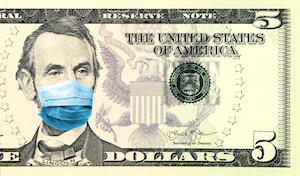 Are retirement plan contributions for small businesses covered under the CARES Act’s Paycheck Protection Program?
Are retirement plan contributions for small businesses covered under the CARES Act’s Paycheck Protection Program?
Section 1102 of the Coronavirus Aid, Relief, and Economic Security (CARES) Act of 2020 creates a Paycheck Protection Program (PPP)[i] to help small businesses affected by the COVID-19 crisis by covering their near-term operating expenses and providing incentives to retain employees. PPP loans will be fully forgiven when used for certain expenses, including payroll costs. Among other things,[ii] under section 1102, payroll costs include “payment of any retirement benefit.”
Questions have arisen as to how “payments of retirement benefits” are considered when employers are making various payments to retirement plans.
First, it is important to note that no guidance has yet been issued by IRS or the Treasury Department on this provision of the CARES Act. You definitely should be looking closely at the guidance that does get issued on these provisions. Second, although the term “payment of any retirement benefit” seems broad, it appears that it is intended to be limited to payments made by an employer as part of its normal payroll costs.
With that in mind, here are some observations about how retirement plan contributions might be taken into account under this loan program:
- The term “retirement benefits” would seem to include elective deferrals that are made by employees, since these are a deferral of compensation.
- The focus on “payroll costs” would seem to include matching contributions to a defined contribution plan. So, for example, if an employer continues to pay matching contributions during April and May 2020, those amounts could be considered as part of the principal of a loan that is forgiven after the 8-week period expires.
- A profit-sharing contribution that would normally be made at the end of 2020 for a retirement plan would not seem to be included in payroll costs incurred during an 8-week period (where the covered period ends June 30, 2020). Similarly, it is unclear whether matching contributions made at the end of the plan year would be included in payroll costs. Similarly, contributions to defined benefit plans would not seem to be included in payroll costs.
- With respect to matching contributions made in the past (i.e., at the beginning of the covered period), and whether those can be part of the loan that is forgiven, it appears the employer is limited to an 8-week period during which loan forgiveness applies. However, if an employer started the 8-week period on February 15 and ended it on April 15, no loan forgiveness would be available after April 15, when the business might be even more severely affected by general shutdowns and shelter-in-place orders. It is not clear how the loan would work for payroll costs incurred prior to the enactment date of the CARES Act, but the statutory provision does provide for a covered period that begins on February 15, 2020. This is an issue where IRS and Treasury guidance would be particularly helpful.
Small businesses with 500 or fewer employees are eligible and can start applying for PPP loans through the Small Business Administration beginning April 3, 2020. Independent contractors and self-employed individuals can apply beginning April 10, 2020.
The covered period during which expenses, including payroll costs as described above, can be forgiven extends from February 15, 2020 to June 30, 2020. Borrowers can choose an 8-week period within the covered period, and loans are forgiven at the end of the 8-week period. Small businesses seeking more information should consult with their lenders, since banks are administering this program on behalf of the SBA and Treasury.
More information is available on the SBA’s website, here.
As with all emerging issues relating to the CARES Act and the COVID-19 crisis, please stay tuned—and please stay safe!
Martin L. Pippins is the American Retirement Association’s Director of Regulatory Policy and the Executive Director of the American Society of Enrolled Actuaries.
[i]Funds are provided in the form of loans that will be fully forgiven when used for payroll costs, interest on mortgages, rent, utilities and other items. The principal amount of the loan is forgiven, but not the full amount of the interest. The loan terms may differ on a case-by-case basis, but generally feature a 2-year term at 0.5% interest, with no prepayment penalties or other fees. Note that there are many more features and requirements of the PPP than are described in this article.
[ii]Those “other things” include compensation for employees in the form of salaries, wages, or commissions; payments of cash tips; payments for vacation, family or sick leave; severance payments; payments for group health care benefits, including insurance premiums; and payments of state or local taxes assessed on employees’ compensation.
The information provided herein does not, and is not intended to, constitute legal advice; instead, all information and content, is for general informational purposes only.

